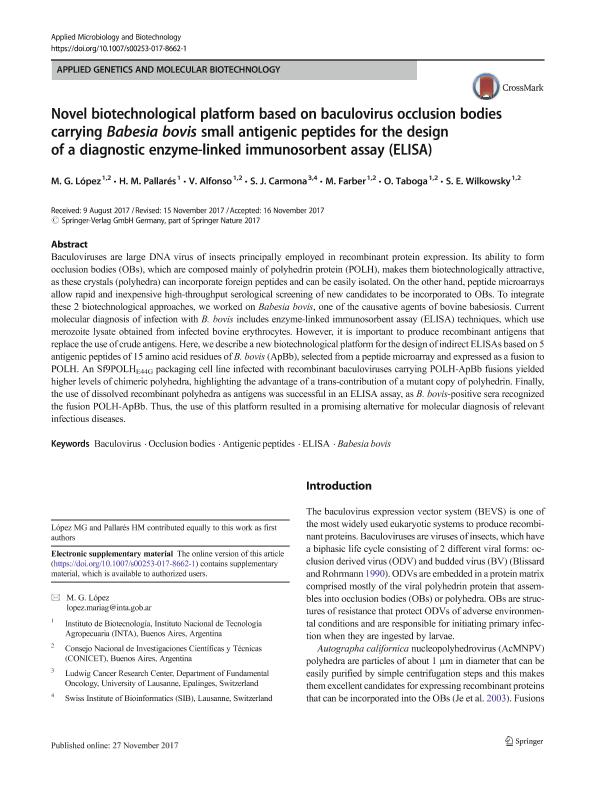Mostrar el registro sencillo del ítem
dc.contributor.author
López, María Gabriela

dc.contributor.author
Pallarés, Horacio Martín

dc.contributor.author
Alfonso, Victoria

dc.contributor.author
Carmona, S. J.
dc.contributor.author
Farber, Marisa Diana

dc.contributor.author
Taboga, Oscar Alberto

dc.contributor.author
Wilkowsky, Silvina Elizabeth

dc.date.available
2018-04-09T20:33:34Z
dc.date.issued
2017-11
dc.identifier.citation
López, María Gabriela; Pallarés, Horacio Martín; Alfonso, Victoria; Carmona, S. J.; Farber, Marisa Diana; et al.; Novel biotechnological platform based on baculovirus occlusion bodies carrying Babesia bovis small antigenic peptides for the design of a diagnostic enzyme-linked immunosorbent assay (ELISA); Springer; Applied Microbiology and Biotechnology; 102; 2; 11-2017; 885-896
dc.identifier.issn
0175-7598
dc.identifier.uri
http://hdl.handle.net/11336/41431
dc.description.abstract
Baculoviruses are large DNA virus of insects principally employed in recombinant protein expression. Its ability to form occlusion bodies (OBs), which are composed mainly of polyhedrin protein (POLH), makes them biotechnologically attractive, as these crystals (polyhedra) can incorporate foreign peptides and can be easily isolated. On the other hand, peptide microarrays allow rapid and inexpensive high-throughput serological screening of new candidates to be incorporated to OBs. To integrate these 2 biotechnological approaches, we worked on Babesia bovis, one of the causative agents of bovine babesiosis. Current molecular diagnosis of infection with B. bovis includes enzyme-linked immunosorbent assay (ELISA) techniques, which use merozoite lysate obtained from infected bovine erythrocytes. However, it is important to produce recombinant antigens that replace the use of crude antigens. Here, we describe a new biotechnological platform for the design of indirect ELISAs based on 5 antigenic peptides of 15 amino acid residues of B. bovis (ApBb), selected from a peptide microarray and expressed as a fusion to POLH. An Sf9POLHE44G packaging cell line infected with recombinant baculoviruses carrying POLH-ApBb fusions yielded higher levels of chimeric polyhedra, highlighting the advantage of a trans-contribution of a mutant copy of polyhedrin. Finally, the use of dissolved recombinant polyhedra as antigens was successful in an ELISA assay, as B. bovis-positive sera recognized the fusion POLH-ApBb. Thus, the use of this platform resulted in a promising alternative for molecular diagnosis of relevant infectious diseases.
dc.format
application/pdf
dc.language.iso
eng
dc.publisher
Springer

dc.rights
info:eu-repo/semantics/openAccess
dc.rights.uri
https://creativecommons.org/licenses/by-nc-sa/2.5/ar/
dc.subject
Antigenic Peptides
dc.subject
Babesia Bovis
dc.subject
Baculovirus
dc.subject
Elisa
dc.subject
Occlusion Bodies
dc.subject.classification
Otras Ciencias Biológicas

dc.subject.classification
Ciencias Biológicas

dc.subject.classification
CIENCIAS NATURALES Y EXACTAS

dc.title
Novel biotechnological platform based on baculovirus occlusion bodies carrying Babesia bovis small antigenic peptides for the design of a diagnostic enzyme-linked immunosorbent assay (ELISA)
dc.type
info:eu-repo/semantics/article
dc.type
info:ar-repo/semantics/artículo
dc.type
info:eu-repo/semantics/publishedVersion
dc.date.updated
2018-04-09T15:09:31Z
dc.identifier.eissn
1432-0614
dc.journal.volume
102
dc.journal.number
2
dc.journal.pagination
885-896
dc.journal.pais
Alemania

dc.journal.ciudad
Berlín
dc.description.fil
Fil: López, María Gabriela. Consejo Nacional de Investigaciones Científicas y Técnicas; Argentina. Instituto Nacional de Tecnología Agropecuaria. Centro de Investigación en Ciencias Veterinarias y Agronómicas. Instituto de Biotecnología; Argentina
dc.description.fil
Fil: Pallarés, Horacio Martín. Consejo Nacional de Investigaciones Científicas y Técnicas; Argentina. Instituto Nacional de Tecnología Agropecuaria. Centro de Investigación en Ciencias Veterinarias y Agronómicas. Instituto de Biotecnología; Argentina
dc.description.fil
Fil: Alfonso, Victoria. Consejo Nacional de Investigaciones Científicas y Técnicas; Argentina. Instituto Nacional de Tecnología Agropecuaria. Centro de Investigación en Ciencias Veterinarias y Agronómicas. Instituto de Biotecnología; Argentina
dc.description.fil
Fil: Carmona, S. J.. Universite de Lausanne; Suiza. Swiss Institute of Bioinformatics; Suiza
dc.description.fil
Fil: Farber, Marisa Diana. Instituto Nacional de Tecnología Agropecuaria. Centro de Investigación en Ciencias Veterinarias y Agronómicas. Instituto de Biotecnología; Argentina. Consejo Nacional de Investigaciones Científicas y Técnicas; Argentina
dc.description.fil
Fil: Taboga, Oscar Alberto. Instituto Nacional de Tecnología Agropecuaria. Centro de Investigación en Ciencias Veterinarias y Agronómicas. Instituto de Biotecnología; Argentina. Consejo Nacional de Investigaciones Científicas y Técnicas; Argentina
dc.description.fil
Fil: Wilkowsky, Silvina Elizabeth. Consejo Nacional de Investigaciones Científicas y Técnicas; Argentina. Instituto Nacional de Tecnología Agropecuaria. Centro de Investigación en Ciencias Veterinarias y Agronómicas. Instituto de Biotecnología; Argentina
dc.journal.title
Applied Microbiology and Biotechnology

dc.relation.alternativeid
info:eu-repo/semantics/altIdentifier/url/https://link.springer.com/article/10.1007/s00253-017-8662-1
dc.relation.alternativeid
info:eu-repo/semantics/altIdentifier/doi/https://doi.org/10.1007/s00253-017-8662-1
Archivos asociados
